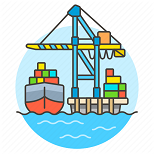It is your choice: Bill Of Lading or Sea Way Bill
(4).png)
For 27 years of our activity, we highlighted in our articles such issues as Bill of Lading types and functions for many times. But our recent case shows that some market players, in the framework of container transportations, still do not understand the principal differences between Bill Of Lading (B/L) and Sea Way Bill (SWB) and potential risks related to using such instruments. Let us emphasize, when it is better to use each type of such documents.
Case study as basis for this article.
The Client (cargo owner, trader, shipper) applied to us for analyzing lawfulness of sea carrier’s and freight forwarder’s actions.
Case circumstances: The Client entered into the Supply Contract, whereunder it undertook to deliver goods in container by sea. Payment should have been made by the Counteragent before cargo arrival at destination port. However, the Counteragent failed to fulfill its obligations, so the Client decided to retain cargo. Since the Client engaged the Forwarder, the latter has been waiting for instructions upon cargo release, with reminder that demurrage has been already accrued for container idle stay at the sea port. Suddenly, the Carrier turned out to have release cargo to the Consignee (the Client’s Counteragent) a few days after cargo arrival at destination port.
Having analyzed the case, we found out that cargo was transported against Sea Way Bill, not Bill Of Lading, while our client was aware of such fact, since it personally confirmed the use of SWB. From the legal and practical aspects, in respect of transportations against SWB, neither the Carrier nor the Forwarder violated their obligations.
Difference in B/L and SWB functions We have already highlighted functions of the Bill Of Lading in our articles (click here for details). Principal ones are the following:
1. Confirming the valid Carriage Contract in accordance with the Sea Carrier’s transportation rules.
2. Confirming by the Carrier the fact of cargo acceptance for transportation.
3. Consignment document.
4. Document of title.
Sea Way Bill has almost the same functions, with one exception: Sea Way Bill is not a document of title.
This function is treated as advantage of the Bill Of Lading: its holder is entitled to dispose of cargo (provided that it is a lawful owner). Therefore, if you want to retain cargo, to sell it during transportation or to receive it with your preliminary consent only, it is reasonable to use Bill Of Lading, not Sea Way Bill.
Difference in cargo receiving procedure
1. Providing original B/Ls
As a general rule, in order to receive cargo carried under the Bill Of Lading, the Consignee shall provide all the original B/Ls to the Carrier at the destination port.
Process is the following:
- The Carrier shall issue original B/Ls to the Consignor at the shipment port.
- The Consignor shall (at its own discretion) transfer original B/Ls, either personally or by mail, to the Consignee.
- The Consignee shall, in turn, submit such documents to the Carrier at the destination port, followed by receiving cargo.
Disadvantages:
- The most expensive option (additional costs for issuing and sending original counterparts).
- There is a risk that cargo will arrive earlier than consignment documents, causing demurrage/detention and other additional expenses. - There is a risk to lose original B/Ls, also causing additional expenses (see our previous article).
- There is a risk of cargo illegal/unlawful retention.
2. Express release
Express release prescribes the procedure of using Sea Way Bill.
In case of issuing SWB, the Carrier undertakes to deliver cargo and to release it to the Consignee indicated in such Way Bill, i.e. the Carrier shall release cargo to the person indicated as the Consignee, without any special instructions or orders from the Consignor.
In such case, original documents shall not be printed out; Sea Way Bill shall be issued ion e-form only.
Such an option mitigates risks being typical of B/L. Although it is the quickest and the cheapest way to receive cargo, such type of document is recommended only for Consignors and Consignees having good business relations, since Sea Way Bill provides not so much defense to the Consignor, as compared to Bill Of Lading.
Disadvantages:
- It is not a document of title (i.e. does not entitle to dispose of/to retain the goods)
- It does not allow changing the Consignee (some line regulations may have exceptions)
3. Telex release
Now, telex release is probably the most popular way to receive cargo: it provides that cargo is transported against Bill of Lading (i.e. with function of the document of title preserved), but with a different procedure of cargo release:
- The Carrier shall issue original BLs to the Consignor at the shipment port.
- The Consignor shall, instead of sending original counterparts to the Consignee, shall hand over the original BL to the Carrier at the shipment port (provided that it has no questions to the Consignee).
- The Carrier shall, via its own channels, provide information to its office at the destination port that all the original documents are collected and the cargo is subject to release.
It is quite an optimal variant, since it mitigates the risks related to providing original B/Ls, with advantages of the Bill Of Lading preserved.
Disadvantage:
- There is a risk of cargo illegal/unlawful retention.
Practical recommendations
In practice, while choosing one of the above instruments (either Bill Of Lading or Sea Way Bill), one should bear in mind some vital nuances, such as understanding your own role in transportation, knowing both your own rights and obligations and counteragent’s, freight forwarder’s, sea carrier’s rights and obligations (including the latter’s rules of transportation). Pros for one party may be cons for the other one.
But the most important is to understand specifications of using each particular document, as well as your goal in the process of its use.
One shall remember that Interlegal law team is always ready to represent your interests in each certain case.
Last but not the least: lifehack to the future
Now the world is changing relentlessly and rapidly like never before. The future is here, and whoever is able to learn and to adapt faster will obviously have a competitive advantage.
As we know, main global carriers and Digital Container Shipping Association members undertook to launch standard Electronic Bill of Lading (eBL) till 2030, while 50% of the original BLs will acquire digital format within the nearest five years. That is a crucial step aimed to avoid commercial disputes, to improve the clients’ experience and to increase sustainability of container transportation.
Today sea carriers issue nearly 45 Bills Of Lading per year. For instance, in 2021 only 1.2% were issued in e-form.
Experts forecast that transformation of sharing the documents via eBL will accelerate the process of digitalization in favor of clients, banks, customs/state authorities, shipping service providers and all the players in the maritime supply chain.
Due to cancelling transfer of hard copies, the parties concerned may save 6.5 billion USD as direct costs, while global trade may increase by 30-40 billion USD every year, having facilitated changes in clients; experience and environmental improvement.
So, the planned changes are impressive and one should get ready right now.
As for our case mentioned above, despite unfavorable comments for the Client, we are still defending its interests in relations with the Counteragent who neither fulfilled its obligations nor paid for the goods. To be continued…
.png)
For 27 years of our activity, we highlighted in our articles such issues as Bill of Lading types and functions for many times. But our r...
.jpg) Interlegal Shipping digest Q4 20222022.12.09
Interlegal Shipping digest Q4 20222022.12.09Interlegal Quarterly Shipping Newsletter BIMCO PUBLISHES UPDATED GENCON-2022 CONTRACT? In order to reflect the commercial and lega...
.png) Interlegal digest - SHIPPING2022.07.13
Interlegal digest - SHIPPING2022.07.13Interlegal Quarterly Shipping Newsletter “Subject to...” – is it an absolute excuse for contract non-performance? DHL Project &...

Ukraine Ports, Shipping and Transport News Bulletin April 2021 MIU Giving Priority to Reform of Inland Water Transport T...

For a party suffering damage from a tort or breach of contract, it may be of key importance to sue not only the person liable, but also the...

FIATA states that freight forwarding companies get involved in nearly 80 % of international transportations by all types...

On the 16th of September, 2014, Ukraine ratified its Association Agreement with the European Union and the European Atomic Energy Community...

General view on service providers’ liability in Ukraine Ukrainian Law does not contain specific provisions as for the service provider...

What is the legal status of a consignee as the person in whose favour a contract of carriage is made...
 Freight-forwarder liability at a glance2013.05.29
Freight-forwarder liability at a glance2013.05.29Introduction In modern practice, the organisation of the transport process often necessitates direct international multimodal transportatio...





 Odessa, 65014, Ukraine, 1 а, Gretska St
Odessa, 65014, Ukraine, 1 а, Gretska St
